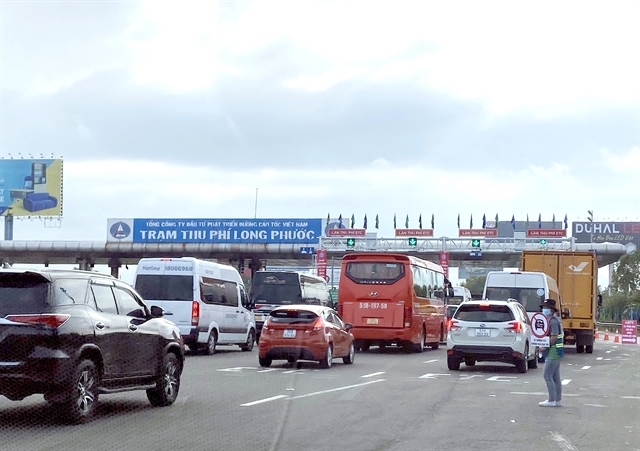 Society
Society

 |
| Cars queue up at a toll gate on Long Thành - Dầu Giây Expressway. —VNA/VNS Photo Mạnh Linh |
HÀ NỘI — With VAT returning to 10 per cent at the start of 2023, toll price changes on several major expressways across Việt Nam have caused confusion and discontent among motorists.
On OF.FB, a one-million membership Facebook group for motorists in Việt Nam, Nguyễn Võ Đạt posted screenshots of the price change announcement from the Vietnam Expressway Corporation (VEC), asking group members about the confusing fluctuation.
Đạt said that before 2022 when VAT rate was 10 per cent, the toll ticket for the entire route of Long Thành - Dầu Giây Expressway cost VNĐ100,000 (US$4.30).
When VAT was changed to 8 per cent, the price was VNĐ98,000. However, when VAT changed back to 10 per cent as of January 1, 2023, the ticket is now VNĐ102,000.
“Then where does the surplus of VNĐ2,000 per vehicle come from?” asked Đạt.
Many other drivers also expressed their annoyance at the price differences when VAT went back to 10 per cent.
On Pháp Vân - Ninh Bình Expressway, a toll ticket for small cars before 2022 (at 10 per cent VAT) was VNĐ105,000 per vehicle ($4.50). At 8 per cent VAT, this figure is VNĐ103,000.
However, the ticket now costs VNĐ110,000, meaning VNĐ5,000 higher than the pre-2022 pricing despite the same VAT rate.
On the section from Km6 to IC7 of Nội Bài - Lào Cai Expressway, toll ticket price for small cars also jumps from VNĐ69,000 ($3) at 8 per cent VAT to VNĐ73,000 ($3.10) at 10 per cent VAT.
In response to the comments, a VEC representative said that the pre-2022 prices were rounded to facilitate toll payment, when electronic toll collection (ETC) was not yet available on these expressways.
The representative said: “To fit the banknotes in circulation and easy payment, VEC made calculations on the principle of rounding the toll fee rates, most of which became lower than the actual prices to benefit motorists.”
According to VEC, the toll rates are determined based on the number of kilometres a vehicle travels on an expressway.
Speaking to Thanh Niên (Youth) newspaper, VEC said that since August 1 last year, when the ETC went into operation on all expressways, transactions are made automatically on drivers’ accounts and no longer depended on the available banknotes.
The company’s representative said: “VEC only rounds the fee pricing to the thousands of đồng.
“Adjustments in the calculation methods lead to small changes in the previous and current prices. The adjustment is for correct and sufficient calculations, not a price increase.”
However, on Hà Nội - Hải Phòng Expressway, which is managed by a different company named Vietnam Infrastructure Development and Finance Investment JSC (VIDIFI), the toll price increased by exactly 2 per cent VAT upon the tax rate changes, from VNĐ206,000 ($8.8) to 210,000.
A VIDIFI manager said that when the VAT rate was reduced to 8 per cent in 2022, the company reduced toll price by two per cent, and when the VAT changed back to 10 per cent the toll ticket also returned to the previous rate.
Nguyễn Văn Thanh, former president of Vietnam Automobile Transportation Association believes that if a company wants to adjust the pricing, it must be transparent and make public the information prior to the change.
He said: “VEC explained that the previous prices were rounded, and now with ETC the calculations are correct and sufficient.
“However, the fact is that the company has increased the toll fees compared to the previous pricing.
“The increase is not a lot, customers are not greatly affected, but companies must not be ambiguous.”
Thanh said that with the old manual toll collection method, this situation would definitely “cause a scene,” but with the new non-stop automatic system, drivers are in a passive position and only find out about the change when they arrive home.
VEC currently manages the largest number of expressways across the countries, with four routes in the northern, central and southern regions. Those are Nội Bài - Lào Cai, Cầu Giẽ - Ninh Bình, Đà Nẵng - Quảng Ngãi and HCM City - Long Thành - Dầu Giây.
According to the company’s 2022 report, the total traffic on these four highways reached 53.3 million, an increase of 41.3 per cent compared to the previous year.
Along with the increased traffic, VEC’s total revenue from toll collection (VAT included) is VNĐ4.5 trillion, rising by 36.4 per cent compared to 2021.
It is estimated that with the traffic of 50 million vehicles per year, an addition of VNĐ2,000-5,000 ($0.08-0.2) in toll price per vehicle could result in VNĐ100-250 billion more in the annual revenue. — VNS